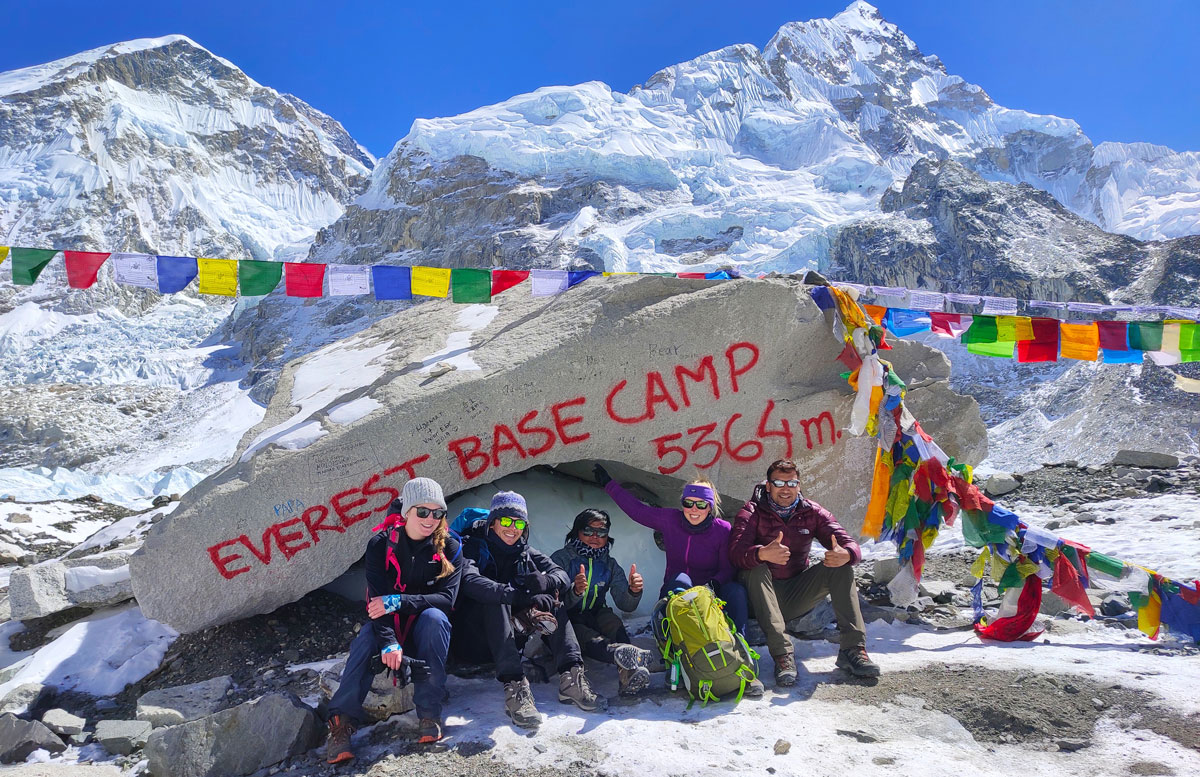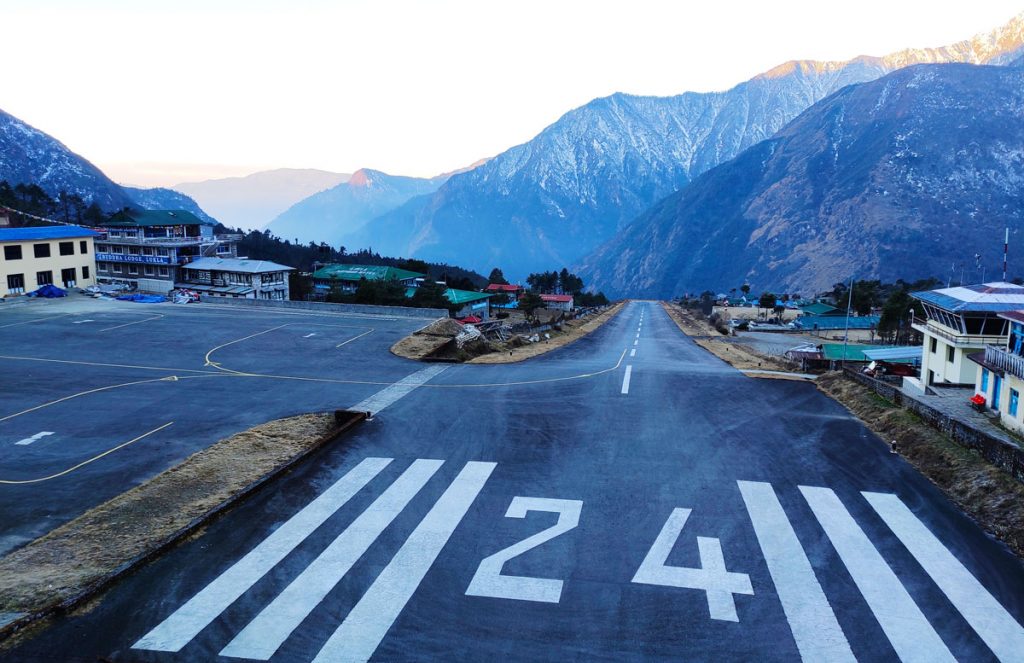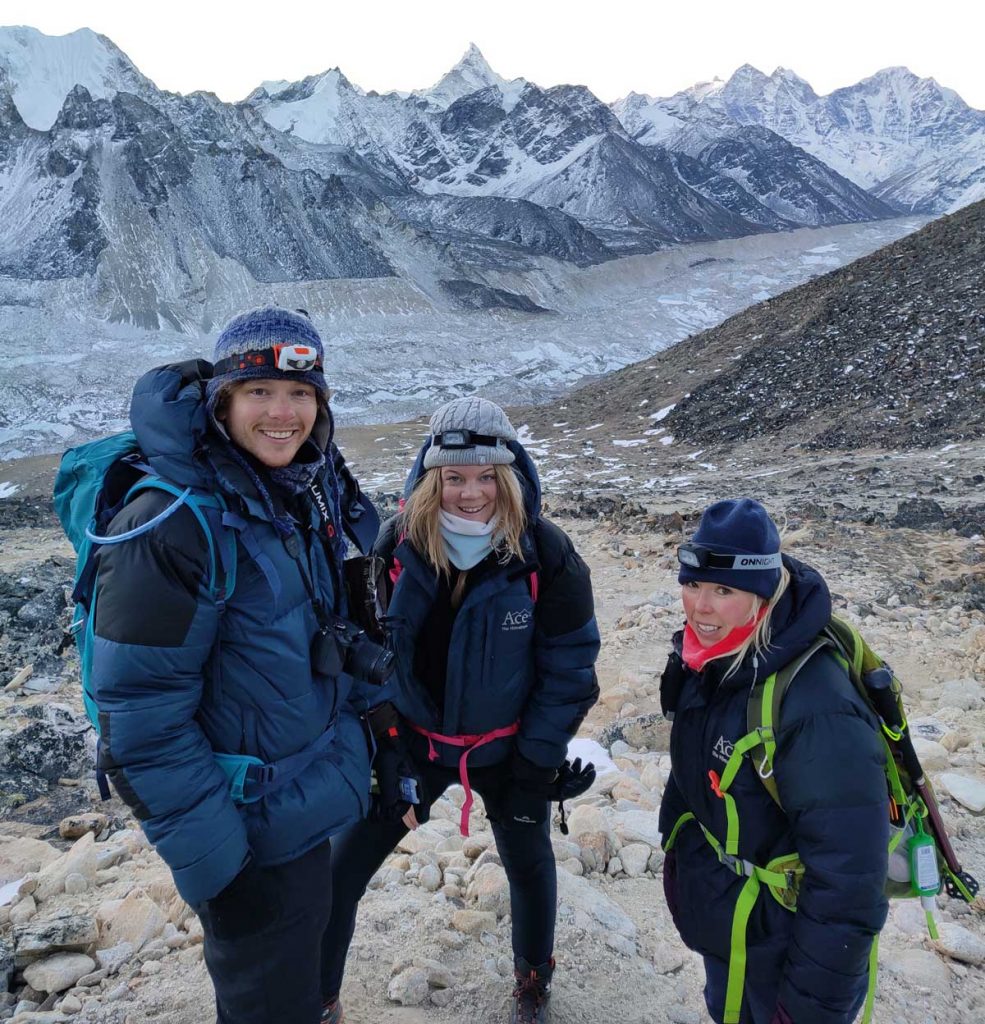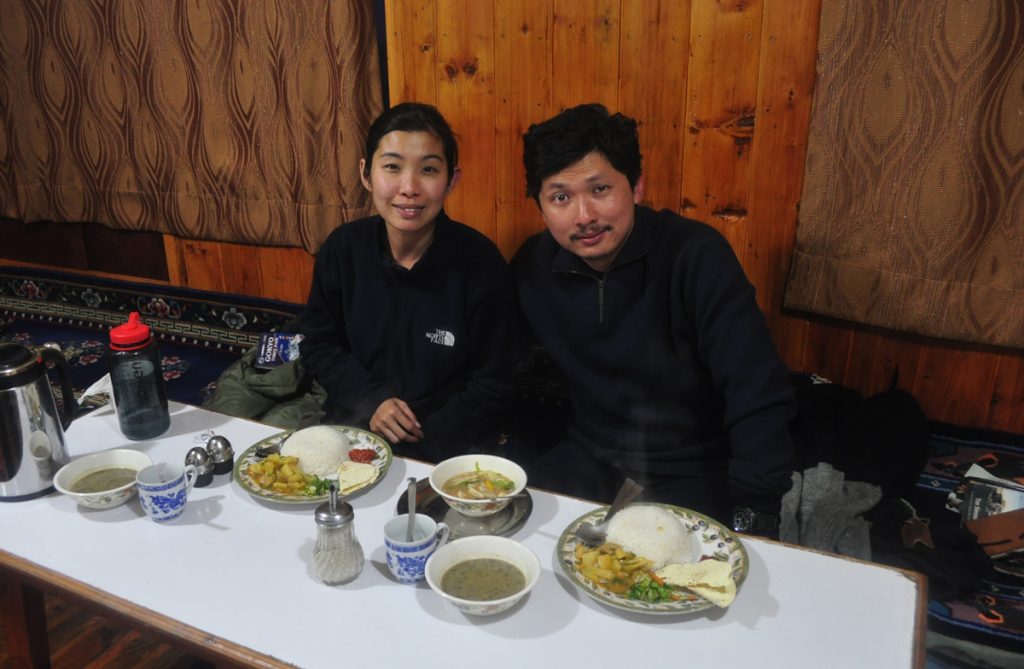Everest Base Camp Trek: A Traveler’s Guide

Trekking to Everest Base Camp means trekking to the base of the world’s highest peak – Mt. Everest. The sojourn to base camp is ideal for catching clear mountain views and experiencing the breathtaking beauty of the giant Himalayan peaks.
The trek route winds through the lush greenery of Sagarmatha National Park, an UNESCO World Heritage Site while offering the stunning views of snow capped peaks like Mt. Everest, Lhotse, Nuptse, Ama Dablam, Pumori, Thamserku etc. along the way.
For those seeking the cultural beauty, the Sherpa’s villages en route are another major attraction where you can experience their warm hospitality. The locals run tea houses where you can have meals and enjoy an overnight stay.
The panoramic summit view of Mt. Everest and neighboring peaks from Kala Patthar are truly breathtaking. Again, the rugged trail has good climbs, so the top view is worthwhile as you set out on this hardship journey.
But wait, there’s much more. While it sounds exciting to hike to the top of the world, this is not a normal hike unlike other treks in the mountain. You need much more planning and preparation before you start your journey.
For travellers, we have covered everything you need to know before your Everest Base Camp Trek in this article. Keep on reading.
Everest Base Camp Trek at a Glance
Location: Eastern Nepal, Province 1, Solukhumbu district
Trek Duration: 14 – 16 days
Trek Distance: It varies depending on the trek route, in general the distance is about 130 km round trip to and from Lukla.
Highest point of the trek: Kala Patthar, 5,555 m
When to hike the Everest Base Camp?
Hiking the Everest Base Camp can be done all year round – but there are best times most trekkers prefer to go.
The two popular seasons for trekking to Everest Base Camp are Spring (March, April, May) and Autumn (October, November and December). This time is favourable for magnificent mountain views, suitable weather, watching birds and wildlife of the Himalayas.
Besides them, the weather condition varies in other seasons; winter being harsh cold time causing heavy snowfalls whereas monsoon brings heavy downpour and slippery trails.
However, normally overcrowded trails during peak seasons are less crowded during monsoon and winter. And you’ll find plenty of time to explore the surroundings and rejoice in breathtaking mountain views.
Find more details on our blog: Everest Base Camp weather – Best seasons to hike.
How to get to Everest Region from Kathmandu?
The Everest region, being a remote mountainous area, transportation facilities are very limited there. The easiest way to get to the Everest region is via plane or helicopter.

That being said, regular flights operate from Kathmandu to Lukla airport. For more details, read our blog – Lukla flight: Everything you need to know about.
Alternatively, the old trail route to get to Lukla is via Jiri. It’s a popular trek route walked by renowned mountaineers Sir Edmund Hillary and Tenzing Norgay Sherpa for their first Mt. Everest expedition. However, it takes an 8 hours jeep drive to reach Jiri, then 11 additional days just to reach Lukla and then exit back to Jiri which is a very long time compared to the new trek route.
How fit should you be for Everest Base Camp Trek?
Everest Base Camp Trek is classified as a strenuous trek as you hike at an altitude between 4000 m-5000 m. The higher altitude region is alpine, comprising rocky, steepy hills. The oxygen level is lower at higher altitude regions compared to sea level, which may cause altitude sickness. Although the trail doesn’t demand technical climbing skills; a good fitness level is essential to complete this trek.

We suggest trekkers to prepare well before hiking to EBC. For a good start, you can add cardio training, strength and conditioning exercises in your workout routine. You can train 3-4 times per week for 2-3 months to prepare physically for the trek. If possible, we suggest you do some hiking or spend 4-5 nights at higher elevations that helps you to pre-acclimatize before the actual trek. Besides physical training, you should be mentally fit. Having the right attitude and positive affirmations is a must to enjoy this trek fully.
For more details, read our blog – 3 excellent training tips to get you prepared for EverestBase Camp Hike.
What are the essential packing lists for Everest Base Camp Trek?
You can buy or rent trekking gear in Kathmandu required for the Everest Base Camp Trek. You can buy all kinds of trekking gear and climbing equipment here from reputed brands. Also, you will find knock-off products labelled The North Face or Mountain Hardwear in cheap price, which you should be aware of when buying as they lack good quality and durability compared to original ones.
For more details on the essential packing lists, Check out Equipment lists for the Everest Base Camp Trek.
The above essential packing list can be used for all treks inside Nepal. You should always consider the season when buying trekking gears. Especially when trekking in the winter season (January and February) in the Everest region, you should include extra layer clothes and a good quality down jacket with hood in your packing list.
Things to know before trekking in the Everest Region
Flight Delay and Cancellations
Lukla Flight is the quickest way to get to the Everest region. However, flights in this region heavily depend upon weather. Flight delay and cancellations are likely to happen frequently due to extreme weather conditions.
The geographical positioning of Lukla airport at high elevation causes frequent changes in temperatures and precipitation patterns. As the flight operation heavily depends upon various factors such as air pressure, visibility and wind speed, the changing weather condition often causes flight delay and cancellation. That’s why, we suggest you include at least 2 extra days besides the itinerary duration for this trek.
Acute Mountain Sickness
Everest region, being a high altitude region, trekkers may experience mild altitude sickness during the trek. It has nothing to do with the fitness level of a person as it happens due to low oxygen levels at high altitude. Some common symptoms are headache, nausea, dizziness, loss of appetite, shortness of breath, problems with sleeping etc. That may sound scary for some travellers but with some preparation you can avoid altitude sickness in so many ways.
What to do to prevent Acute Mountain Sickness?
- Hike slowly to adjust your body at higher altitude. Avoid hurried walking even if you are an experienced trekker.
- Take proper acclimatization rest. In general, most Everest Base Camp itineraries include 2 days for acclimatization at Namche Bazaar and Dingboche, which is sufficient for the trekkers.
- Always climb high at day and sleep at low altitude regions.
- Avoid alcohol, cigarettes and tobacco during the trek as it causes dehydration that further results in acute mountain sickness.
- Avoid sleeping pills even if you have difficulty while sleeping.
- Keep your body well hydrated. Drink plenty of warm water and soups (4 liters) to avoid acute mountain sickness.
- Consume dark chocolate (cocoa) and tea during the trek.
- Communicate honestly with your trekking guide about your health conditions.
- Take medications such as Diamox (Acetazolamide) if necessary under the physician’s prescription.
Khumbu Cough
Trekkers in the Everest region often experience high altitude cough, also known as Khumbu Cough among locals during the trek. Although the name is derived from the geographical location of Khumbu Valley, it is not limited to the Everest region.
While the exact causes haven’t been much known, several environmental factors such as low humidity, cold climate and low oxygen level above 3,000 m altitude are identified with this condition. Common symptoms include a runny nose and sputum production while severe symptoms result in persistent coughing that can cause damage to chest muscles and ribs.
On the other hand, you can prevent it by taking the following precautions:
- Wearing a buff or balaclava during the trek.
- Breathe from the nose properly and avoid the mouth.
- Dress properly with warm layers.
- Drink plenty of warm water.
Travel Insurance
Everest region is a remote mountainous region with very limited basic facilities. There are several risks that may occur during hiking such as acute mountain sickness, lost goods, natural disasters, accidents etc. That’s why, it’s recommended for trekkers to cover travel insurance for high altitude (above 4000 m) adventurous activities especially for Everest Base Camp Trek that includes emergency medical costs, helicopter rescue and evacuation. Not only this allows you to trek peacefully without any worries but also saves you lots of money.
What sort of facilities are available in the Everest Base Camp Trek?
Accommodation
Everest Base Camp Trail, being one of the oldest trail routes used by travellers and traders from Tibet and Nepal, there are plenty of accommodation facilities available in the Everest region.
Mostly, you will find tea houses run by the local families offering food and lodging services for the guests. Also, you will find mid level and luxury hotels offering the basic facilities to the best hospitality services one can expect in the highly remote mountainous region.
However, during peak seasons, independent trekkers may have difficulty in getting accommodation facilities compared to large groups traveling with trekking agencies and guides. So we recommend you to travel with the local trek operators as they include food and accommodation services in their trip package so you don’t have to worry about it at all.
For more information, read “Trekking Accommodation in Everest Region – A complete guide.”
Food
In the Everest region, you will find a similar food menu in most places. The price ranges remain expensive in the higher altitude region due to the difficulty in transporting goods. Also, you will find mid range and luxury hotels offering multi cuisine dishes.

In general, the breakfast menu includes toast, eggs, potatoes, Tibetan breads, tea, coffee, to mention a few. The lunch and dinner menu includes popular staple food of Nepal: steamed rice, vegetables, lentils and pickles. Likewise, you will find snacks such as momo, noodles, chowmein, garlic soup, pancakes, bakery items etc.
Likewise, meat consumption is not allowed in the Everest region because of the local’s religious faiths. You will find meat items in the menu, but we suggest you not eat meat during the trek as they are imported from other regions and are unhealthy due to lack of proper refrigeration.
Drinking Water
The natural water sources in the Everest region are not safe for drinking as they are rich in minerals. For health reasons, trekkers can drink boiled water available at a cost ($1 -$6) in tea houses. Also, trekkers can bring their own bottle and collect tap water, and be treated with SteriPEN or Purification tablets for drinking purposes.
As the local government of Khumbu has banned plastic bottles from January 2020, we suggest you not to rely on bottled mineral water, instead carry your own bottles that can take hot water.
Wi Fi/ Internet
Everest region is connected with internet facilities in every place. Wi Fi facilities are offered in most guest houses at a cost. However, the internet speed may vary, and may not work like in your home country.
Likewise, you can stay connected with Wi-Fi hotspots using high speed broadband services offered by local ISP – Everest Link during the trek.
Electricity
Electricity facilities work well in the Everest region. Mostly, you will find electricity in the lower altitude villages whereas the higher altitude regions are mostly equipped with solar panels. There is no problem for charging electronic devices but they may charge a certain fee for charging facilities.
Conclusion
And, that’s all about the information you should know before trekking to Everest Base Camp. Whether you are planning for an EBC trek or an experienced one, we hope you find this article helpful. And, if you did, don’t forget to share with your friends and family on social media.
Last but not least, if you are looking for local trekking companies in Nepal, we, Trekking to Nepal, operate an exciting Everest Base Camp Trek 14 days trip, and you can customize this trip as per your needs. As you can see more on our website, we offer exciting treks in the Everest region as well as other parts of Nepal. Come and experience this adventurous journey to the Himalayas with us.

